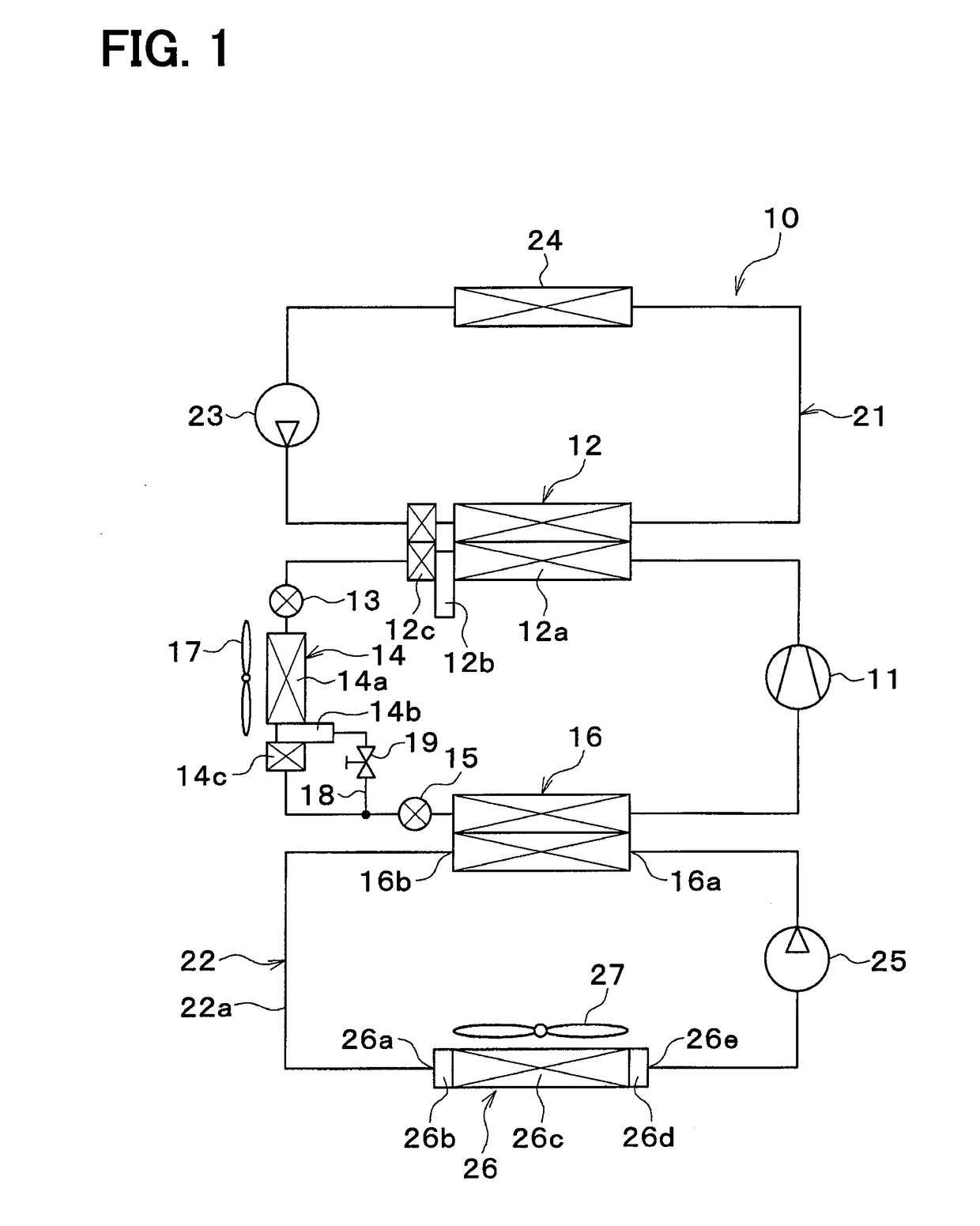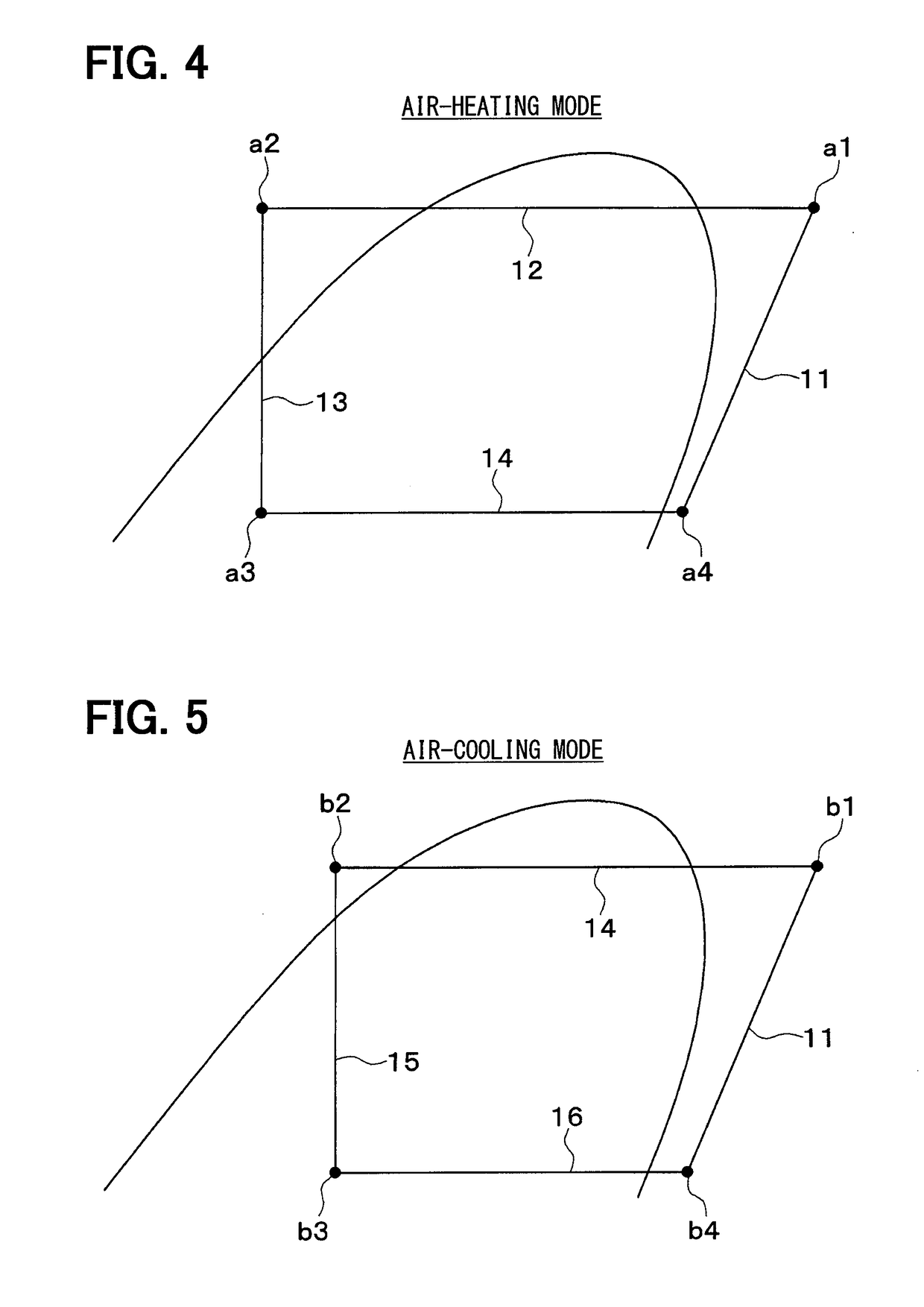Refrigeration cycle device
a technology of refrigerating cycle and refrigeration chamber, which is applied in the direction of subcoolers, compression machines with several condensers, lighting and heating apparatus, etc., can solve the problems of reducing the volume of air passing through the interior evaporator, failing to obtain the heat exchange capacity required by the interior evaporator, and freezing of condensed water generated at the surface of the interior evaporator to form frost, etc., to achieve the effect of reducing the amount of fros
- Summary
- Abstract
- Description
- Claims
- Application Information
AI Technical Summary
Benefits of technology
Problems solved by technology
Method used
Image
Examples
first embodiment
[0068]A refrigeration cycle device 10 shown in FIG. 1 is a vehicle refrigeration cycle device used for adjusting the temperature of an interior space of a vehicle to an appropriate temperature. In the present embodiment, the refrigeration cycle device 10 is applied to a hybrid vehicle that obtains a driving force for traveling from both an engine (in other words, an internal combustion engine) and a traveling electric motor.
[0069]The hybrid vehicle in the present embodiment is configured as a plug-in hybrid vehicle that can charge a battery mounted on the vehicle (in other words, a vehicle-mounted battery) with power supplied from an external power source (in other words, a commercial power source), when the vehicle is stopped. For example, a lithium ion battery can be used as the battery.
[0070]The driving force output from the engine is used not only to cause the vehicle to travel, but also to operate a power generator. The power generated by the power generator and the power suppl...
second embodiment
[0202]As shown in FIGS. 8 and 9, a refrigeration cycle device 10 in the present embodiment includes a heat supply device 40. The heat supply device 40 is a device that supplies heat to the coolant. In the heat supply device 40, the coolant circulates. Examples of the heat supply device 40 include a heat generating device, a ventilation heat recovery heat exchanger, and the like.
[0203]Examples of the heat generating device include an engine, a travelling electric motor, a battery, an inverter, a DC-DC converter, a turbocharger, an intercooler, an EGR cooler, a CVT cooler, and the like.
[0204]The ventilation heat recovery heat exchanger is a heat exchanger that recovers heat exhausted by ventilation. The ventilation heat recovery heat exchanger is the heat exchanger that exchanges heat between the coolant and air discharged from the vehicle interior to the outside of the vehicle cabin for ventilation.
[0205]In a first example shown in FIG. 8, the heat supply device 40 is disposed in the...
third embodiment
[0218]As shown in FIG. 12, a refrigeration cycle device 10 may include an internal heat exchanger 45. The internal heat exchanger 45 has a high-pressure side refrigerant passage 45a and a low-pressure side refrigerant passage 45b.
[0219]The internal heat exchanger 45 is a heat exchanger that exchanges heat between the high-pressure side refrigerant circulating through the high-pressure side refrigerant passage 45a and the low-pressure side refrigerant circulating through the low-pressure side refrigerant passage 45b.
[0220]The high-pressure side refrigerant passage 45a is disposed on the refrigerant-flow downstream side of the exterior heat exchanger 14 and on the refrigerant-flow upstream side of the second expansion valve 15. The low-pressure side refrigerant passage 45b is disposed on the refrigerant-flow downstream side of the low-pressure side heat exchanger 16 and on the refrigerant suction side of the compressor 11.
PUM
 Login to View More
Login to View More Abstract
Description
Claims
Application Information
 Login to View More
Login to View More - R&D
- Intellectual Property
- Life Sciences
- Materials
- Tech Scout
- Unparalleled Data Quality
- Higher Quality Content
- 60% Fewer Hallucinations
Browse by: Latest US Patents, China's latest patents, Technical Efficacy Thesaurus, Application Domain, Technology Topic, Popular Technical Reports.
© 2025 PatSnap. All rights reserved.Legal|Privacy policy|Modern Slavery Act Transparency Statement|Sitemap|About US| Contact US: help@patsnap.com



